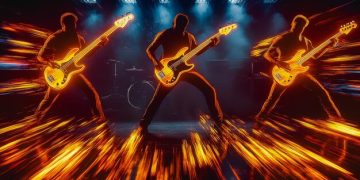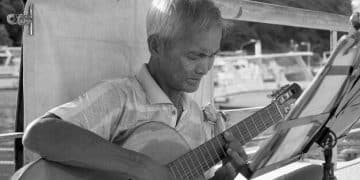Rock Artists’ Creative Secrets: Podcast Interview Insights
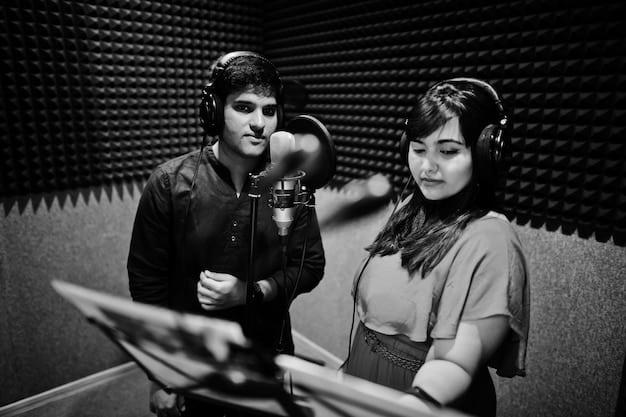
Recent podcast interviews reveal rock artists’ diverse creative processes, offering insights into songwriting, collaboration, and overcoming creative blocks.
What can we learn when rock artists pull back the curtain on their artistic methods? Recent podcast interviews offer unprecedented access to their minds, unveiling the diverse approaches to songwriting, collaboration, and navigating the often-turbulent waters of creative blocks. Let’s dive into what what Rock Artists Reveal About Their Creative Process in Recent Podcast Interviews.
The Evolving Landscape of Rock Music
The landscape of rock music is constantly evolving, adapting to new technologies, cultural shifts, and the ever-changing tastes of audiences. This evolution impacts not only the sound of rock but also the creative processes of the artists behind the music.
Understanding how rock artists navigate this dynamic environment offers valuable lessons applicable far beyond the realm of music.
The Influence of Technology on Songwriting
Modern technology has revolutionized songwriting, providing artists with tools and possibilities that were unimaginable just a few decades ago. Digital audio workstations, virtual instruments, and online collaboration platforms have democratized music creation, allowing artists to experiment and produce music from virtually anywhere.
- Accessibility: Software like Ableton Live and Logic Pro X allow artists to craft songs without traditional studio settings.
- Experimentation: Guitar effects and advanced production plugins fuel the exploration of uncharted sonic territories.
- Collaboration: Online platforms enable seamless collaboration among band members across geographical distances.
These technological advancements enable artists to explore sounds, textures, and arrangements that might have been inaccessible in the past, leading to innovative and genre-bending compositions.
The blend of old and new technologies can create a unique creative experience, fostering innovation while respecting the genre’s roots.
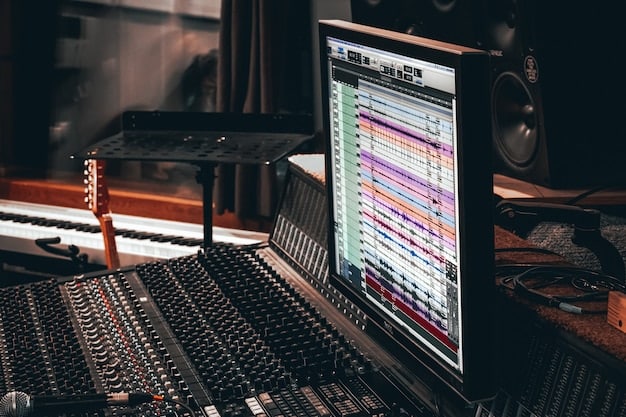
Collaborative Dynamics: The Band as a Creative Unit
Collaboration is a cornerstone of rock music, where the interplay between band members often sparks unique and unforgettable musical moments. The creative dynamics within a band can be complex, but when harnessed effectively, it can lead to extraordinary results.
Understanding how successful rock bands foster collaboration provides insights into effective teamwork and shared creative vision.
Shared Vision and Individual Contributions
Successful collaboration requires a delicate balance between a shared vision and individual contributions. Each band member brings unique skills, perspectives, and influences to the table, contributing to the overall sound and direction of the music. Recognizing and valuing these individual contributions is essential for a healthy and productive creative environment.
Even bands with strong leaders value the input and ideas of every member, fostering a sense of ownership and shared responsibility.
- Communication: Regular discussions where everyone’s ideas are heard are paramount to a group’s well-being.
- Compromise: Understanding that not every idea will be used is crucial for the creative flow of a band.
- Respect: Valuing each band member’s expertise makes them more inclined to contribute.
The most successful bands use healthy conflict to generate unique music that could not have been created solo.
By embracing the mix of ideas, successful bands create music that exceeds the potential of any lone creator.
Overcoming Creative Blocks: Strategies from the Masters
Creative blocks are an inevitable part of the artistic process, often leaving artists feeling frustrated and uninspired. However, many rock artists have developed strategies and techniques for overcoming these blocks and reigniting their creative spark.
Examining these strategies can inspire musicians and artists in any field to persevere and find new avenues for creative expression.
Changing Environment
Sometimes all that is needed is a change of scenery. Many artists find that going to a different room, city, or even country can have a profound effect on their mental state and, therefore, their creativity. A new environment provides new sights, sounds, and experiences that can trigger new ideas and perspectives.
Sometimes a walk around a new neighborhood can offer more than hours spent staring at an instrument.
- New cultures: Immersing oneself in an unfamiliar cultural setting can foster innovative ideas.
- Outdoor Activities: Simply stepping outside can get blood flowing that unblocks mental logjams.
- Minimalism: Sometimes getting away from instruments altogether is necessary for a fresh perspective.
Stepping outside comfort zones is the primary goal of changing one’s environment.
When change of environment is used in concert with other techniques, the artist doubles down on their creativity.
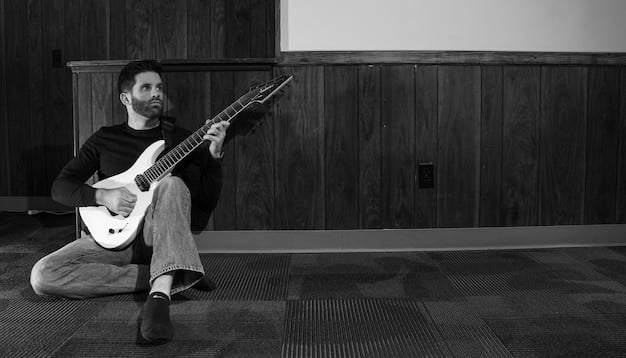
The Role of Personal Experiences in Rock Music
Personal experiences are often a wellspring of inspiration for rock artists, shaping the themes, emotions, and narratives that permeate their music. Drawing from their own lives allows artists to connect with listeners on a deeper level, creating music that is both authentic and relatable.
Understanding how rock artists translate personal experiences into their music sheds light on the power of art as a medium for self-expression and connection.
Transforming Pain into Art
Many rock artists have transformed personal pain and adversity into cathartic and powerful music. Experiences such as heartbreak, loss, and struggles with mental health are often channeled into songs that resonate with listeners who have faced similar challenges. By sharing their vulnerability, artists create a sense of community and offer solace to those who may be suffering.
The most moving music uses the artist’s emotions to uplift the audience.
In using personal experiences to create music, the artist can bond with their audiences.
The Impact of Genre Blending on Rock’s Creativity
Genre blending may have been the future decades ago, but now is a very present form of music production. Rock artists are increasingly blending their work with other genres, such as hip-hop, electronic, and pop, to create new and exciting sonic landscapes.
Understanding this shift can give the artist insight to creating new and engaging trends.
Understanding a Changing Industry
The music industry has changed drastically in recent years, and artists of all genres are now required to understand those changes and to adapt. The same old methods will no longer work as the internet brings ever-wider audiences into the fold.
New music requires a new approach to the music business.
- Gone Viral: Some segments of songs are specifically crafted to make the piece get shared.
- Authenticity: The goal is not to copy another but to add to the canon.
- Be a Fan: Artists often connect to other artists, creating a community of creatives.
Artists often rely on each other to get new perspectives on business and creation.
Artists who adopt changes in the industry have a better shot at gaining influence in the future.
Future Trends in Rock Music Creation
As technology continues to evolve and cultural landscapes shift, the future of rock music creation is ripe with possibilities. Emerging trends such as artificial intelligence, virtual reality, and blockchain technology are poised to further transform how rock artists create, collaborate, and connect with their audiences.
Speculating on these future trends provides a glimpse into the potential evolution of rock music and the creative processes that will shape it.
AI-Assisted Composition
Artificial intelligence (AI) is increasingly being used as a tool for music composition, offering artists new ways to generate ideas, explore sonic textures, and push the boundaries of their creativity. AI algorithms can analyze vast amounts of musical data, identify patterns, and generate novel melodic, harmonic, and rhythmic ideas. While AI is unlikely to replace human creativity entirely, it can serve as a powerful source of inspiration and experimentation.
AI can even be used to mimic the work of artists, helping bands come up with their new sound.
The combination of man and machine opens doors to sounds not yet heard.
| Key Concept | Brief Description |
|---|---|
| 🎸 Technology’s Role | Digital tools enhance songwriting and open new soundscapes. |
| 🤝 Band Collaboration | Balancing shared vision with individual ideas is key. |
| 🧠 Overcoming Blocks | Fresh perspectives and new environments spark creativity. |
| 🎤 Personal Experiences | Pain transformed into deeply resonant, connective art. |
FAQ
▼
Rock artists are now using DAWs like Ableton and Logic to craft songs. This allows them to experiment with new effects or even work online with collaborators. The use of technology has changed music forever.
▼
Communication coupled with compromise is essential. Each artist will have specific ideas of expertise, so having a balance is critical to creating an overall engaging sound. This will also allow the band to stay together.
▼
One of the most used techniques is to change one’s environment. The artist can get away from the studio and visit a museum, forest, or other location. This can free up the mental logjam that comes from a creative block.
▼
Yes. Rock artists use their emotions, experiences, and situations to influence their work. This allows an audience to connect with the artist on a personal level, driving ticket sales and engagement with their pieces.
▼
Music has become ever more collaborative and less about solo performances. There are also ways that artists will write music specifically for it to go viral via new social media platforms, all while staying authentic to their style.
Conclusion
Rock artists’ creative processes are as varied and dynamic as the music they produce. From embracing technology and fostering collaboration to overcoming creative blocks and drawing from personal experiences, these artists demonstrate the power of innovation, resilience, and self-expression. By understanding their methods, aspiring musicians and artists can gain valuable insights and inspiration to fuel their own creative journeys.
